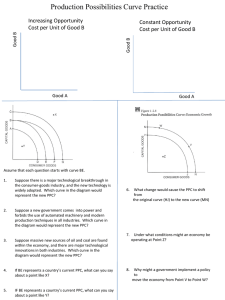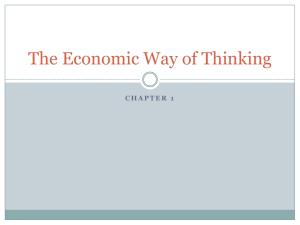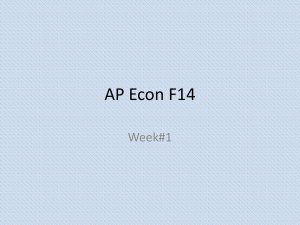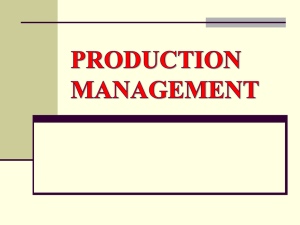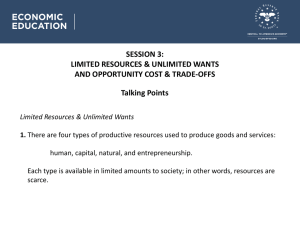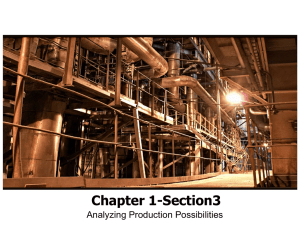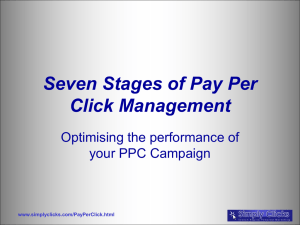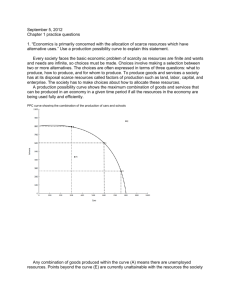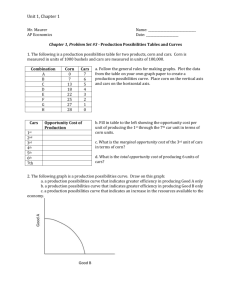PPC
advertisement
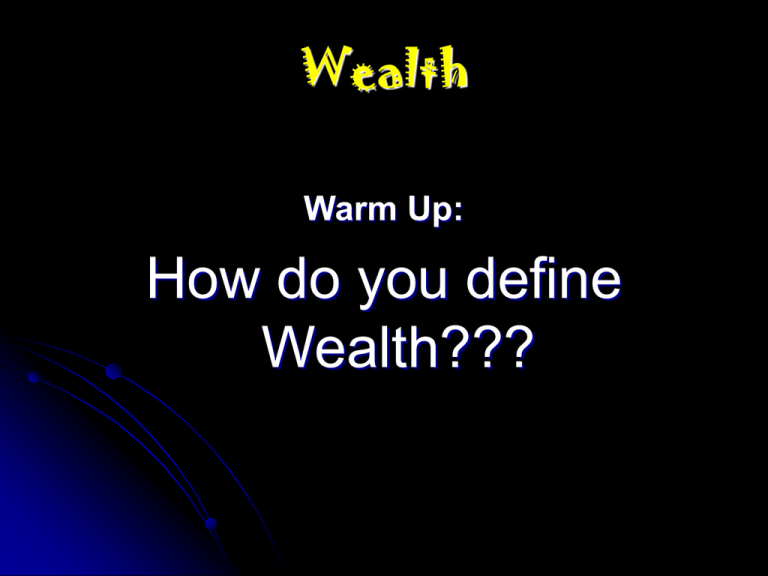
Wealth Warm Up: How do you define Wealth??? Wealth-How do you define it??? Are these all pictures/illustrations of wealth??? NOPE!!!!! WEALTH is resources and the ability to make goods and services from these resources!!! What do you have that makes you wealthy right now?? Remember the Economic Problem… SCARCITY!! of what???? ECONOMIC RESOURCES Types of Resources REVIEW Goods v. Services Good -- An item you can see, feel, and touch and that requires scarce resources to produce and satisfies human wants Services -- Something that is not physical that requires scarce resources to produce and satisfies human wants =>With your partner list 3 Goods & 3 Services… Types of Resources – cont. Natural -- So-called “gifts of nature” used to produce goods and services; includes renewable and exhaustible resources Renewable – A natural resource that can be drawn on indefinitely if used conservatively such as the atmosphere or water supply Exhaustible – A natural resource that does not renew itself and so is available in a finite amount such as oil or copper ore Productive – The inputs, or factors of production, used to produce the goods and services that people want How to achieve economic growth and become…WEALTHY!! 1. 2. 3. 4. Increase Resources (if you have more things, you can produce more goods and services) Improve technology (can make things better and/or faster) Increase capital goods (use machines to get the job done faster) Educate and train the labor force (employees will become more efficient) Production Possibilities Curve (PPC) It represents the “potential production” of a combination a consumer good (i.e. pizza, haircut) and a capital good (i.e. pizza oven, hair clippers) that can be produced if all available resources are present in a given year. Two Assumptions: 1. 2. All resources are being used There is no unemployment Production Possibilities Curve (PPC) Points along the curve represent the possible combinations of the two goods that can be produced when the economy’s resources are used efficiently Shows efficient and inefficient combinations Shows attainable and unattainable combinations Production Possibilities Curve (PPC) Movement along the PPC involves giving up some of one good to get more of the other – what is this called? Movement down the curve indicates that the opportunity cost of more capital goods is fewer consumer goods and vice versa. PPC Y 6 6 X Correctly label and draw the PPC for the following problem. X axis=consumer goods Y axis=military goods A=attainable area B=unattainable area C=all military production D=all consumer production E=greatest opportunity cost in military goods when both types of goods are being produced F=greatest opportunity cost in consumer goods when both types of goods are being produced G=equal use of resources H=no production Identify the points-what does each point represent on this graph??? y LABEL THE WORDS THAT DESCRIBE EACH POINT: b. Possible c. Impossible Efficient a. Inefficient d. x Practicing the PPC!!! Y 10 Correctly label and draw the PPC for the following problem. X axis=apples Y axis=oranges A=all apple production only B=all orange production only C=no production D=equal use of resources E=attainable area F=unattainable area G=greatest opportunity cost in apples when both goods are being produced H=greatest opportunity cost in oranges when both goods are being produced 10 X I=8 apples, 4 oranges J=3 apples, 3 oranges Increased production will shift the PPC to the right. The more it shifts to the right, the greater the economic growth. y x Which graph shows more economic growth??? And why??? Graph A Graph B Three Reasons That Prevent Some Countries From Shifting their PPC to the right: 1. 2. 3. Inefficient Labor Force (if you are being unproductive, your economy cannot grow) No Loans (you can’t invest in economic growth in your economy) Poor Trade Practices (you have nothing to trade) Wrap-Up/Review Below each question/next to each question, or on a separate sheet of paper, briefly explain how you know that is the CORRECT answer!!! 1. What purpose does the production possibilities curve serve? a.) it determines whether the economy is expanding or experiencing a recession b.) it predicts the possible outcomes of a rise in unemployment c.) it proves that while the production of some goods increases the efficiency of the economy, the production of others decreases the efficiency d.) it shows the possible combinations of goods that can be produced when available resources are employed fully and efficiently 2. What do points outside of the PPC indicate? a.) Unattainable combinations of goods b.) Ideal combination of goods c.) Inefficient combination of goods d.) None of the above 3. Economic growth effects the PPC by: a.) Shifting it inward b.) Shifting it outward c.) Causing no change at all d.) Turning it into a straight line 4. Suppose that during a given period an economy produces a large amount of capital goods. What would you expect to happen to the amount of output produced during the following period? a.) Less output would be produced b.) More output would be produced c.) Output would not be affected d.) None of the above 5. Suppose that a new machine that speeds up automobile production is introduced into the auto industry. This would cause the PPC to: a.) Shift outward b.) Shift inward c.) Do nothing d.) Not enough information is given 6. What do points inside the PPC indicate? The combination of goods that employ resources efficiently Combinations of goods that employ resources fully The combination of goods that do not employ resources fully None of the above 7. Which of the following situations might cause an inward shift in the production possibilities curve? a.) A computer network shuts down due to a virus b.) More people earn bachelor degrees c.) A new machine that produces bread faster is invented d.) OPEC announces a new source of oil 8. An increase in the labor force would cause the PPC to: a.) Shift inward b.) Shift outward c.) Do nothing d.) Turn into a straight line 9. In deciding to go to college, which of these may involve an opportunity cost? a.) Value of goods and services that could be purchased with money spent on books b.) Value of goods and services that may be purchased with tuition money c.) Value of goods and services that may be purchased with money spent on boarding d.) All of the above 10. If you must stay at home and study for an upcoming economics test, the opportunity cost of studying would most likely be highest at which of the following times? a.) Monday evening b.) Wednesday morning c.) Thursday afternoon d.) Friday evening 11. Which of the following statements is true of opportunity costs? a.) It is the value of all alternatives you pass up when making a choice b.) It is the value of the best alternative you give up when you make a choice c.) It can only be measured in dollar amounts d.) It is the same for all individuals 12. Economists assume that which of the following leads the average person to choose the most valued alternative among a number of possibilities? a.) Rational self-interest b.) Scarcity c.) Opportunity cost d.) None of the above 13. Which of the following would lead to a sunk cost? a.) Buying a new CD at an outlet store b.) Putting a non-refundable deposit at one college and then attending another c.) Deciding to study on a Friday night instead of going to a party d.) None of the above 14. Which of the following describes a sunk cost? a.) Sunk costs can’t be recovered b.) Sunk costs have already been incurred c.) Sunk costs are irrelevant d.) All of the above 15. What is considered the ultimate limiting factor in making choices? a.) Wealth b.) Knowledge c.) Time


